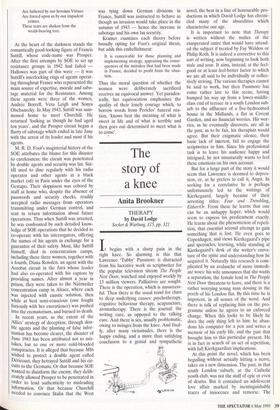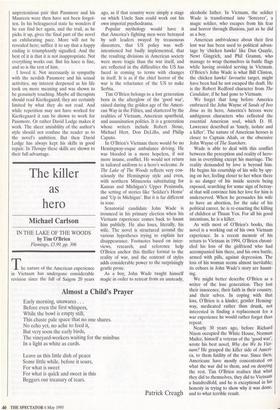The story of a knee
Anita Brookner
THERAPY by David Lodge Secker & Warburg, US, pp. 321 It begins with a sharp pain in the right knee. So alarming is this that Lawrence 'Tubby' Passmore is distracted from his lucrative work as scriptwriter for the popular television sitcom The People Next Door, watched and enjoyed weekly by 13 million viewers. Palliatives are sought. There is the operation, which is unsuccess- ful. Then there is the usual trawl for clues to deep underlying causes: psychotherapy, cognitive behaviour therapy, acupuncture, aromatherapy. There is the journal: the writing cure, as opposed to the talking cure. And there is sex, usually problematic, owing to twinges from the knee. And final- ly, after many vicissitudes, there is the happy ending, and a more than satisfying conclusion to a genial and sympathetic novel, the best in a line of honourable pro- ductions in which David Lodge has chroni- cled many of the absurdities which characterise our age.
It is important to note that Therapy is written without the malice of the exasperated satire that would have attend- ed the subject if treated by Fay Weldon or Philip Roth. It is indeed a corrective to this sort of writing, now beginning to look both stale and sour. It aims, instead, at the feel- good or at least feel-better factor to which we are all said to be individually or collec- tively striving. The various therapies cannot be said to work, but then Passmore has come rather late to this scene, having bumped his way up from a lower-middle- class end of terrace in a south London sub- urb to the affluence of a five-bedroomed house in the Midlands, a flat in Covent Garden, and no financial worries. His wor- ries, as he eventually discovers, are all in the past, as to be fair, his therapists would agree. But their enigmatic silence, their basic lack of injerest, fail to engage the scriptwriter in him. Since his professional task is to leave his audience happy and intrigued, he not unnaturally wants to feel these emotions on his own account.
But for a large part of the story it would seem that Lawrence is doomed to depres- sion, or, as he prefers to call it, Angst. In seeking for a correlative he is perhaps unfortunately led to the writings of Kierkegaard, largely because of their arresting titles: Fear and Trembling, Either/Or. From these he learns that one can be an unhappy hoper, which would seem to express his predicament exactly. He learns about the phenomenon of repeti- tion, that essential second attempt to gain something that is lost. He even goes to Copenhagen, and views Kierkegaard's pipe and spectacles, learning, while standing at Kierkegaard's desk of the writer's curva- ture of the spine and understanding how he acquired it. Naturally this research is com- plicated by an avalanche of more immedi- ate woes: his wife announces that she wants a separation, the female lead in The People Next Door threatens to leave, and there is a rather worrying young man dossing in the porch of his London flat. By this time he is impotent, in all senses of the word. And there is talk of replacing him on the pro- gramme unless he agrees to an enforced change. When this looks to be likely he does the only thing left to him: he aban- dons his computer for a pen and writes a memoir of his early life, and the past that brought him to this particular present. He is in fact in search of an act of repetition, with full Kierkgaardian implications.
At this point the novel, which has been beguiling without actually hitting a nerve, takes on a new dimension. The past, in that south London suburb, at the Catholic youth club, was not the stuff of epic or even of drama. But it contained an adolescent love affair marked by inextinguishable traces of innocence and remorse. The unpretentious pair that Passmore and his Maureen were then have not been forgot- ten. In his beleaguered state he wonders if he can find her again, and the trail, as he picks it up, gives the final part of the novel an exhilarating pace. More will not be revealed here; suffice it to say that a happy ending is triumphantly signalled. And the best of it is that it is not inappropriate. Not everything works out. But his knee is fine, and so is the rest of him.
I loved it. Not necessarily in sympathy with the nerdish Passmore and his sexual activities, my interest deepened as his life took on more meaning and was shown to be genuinely touching. Maybe all therapists should read Kierkegaard; they are certainly limited by what they do not read. And while repetition may not have worked for Kierkegaard it can be shown to work for Passmore. Or rather David Lodge makes it work. The sheer amiability of the author's style should not confuse the reader as to the novel's ambition. But then David Lodge has always kept his skills in good repair. In Therapy these skills are shown to their full advantage.



































































 Previous page
Previous page